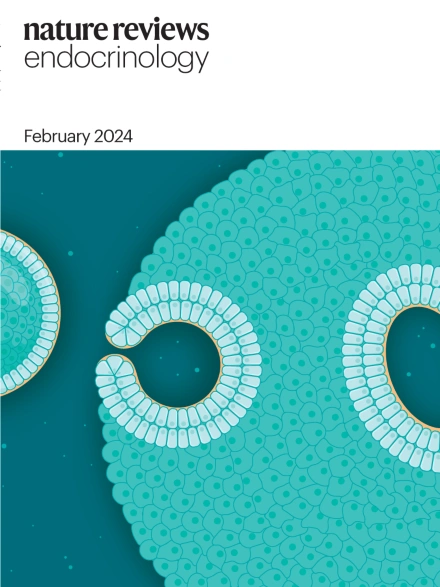Hyponatraemia in ageing
IF 40
1区 医学
Q1 ENDOCRINOLOGY & METABOLISM
引用次数: 0
Abstract
Hyponatraemia is the most common electrolyte disorder in both inpatient and outpatient settings and mostly affects older adults, in whom intrinsic factors (such as chronic heart, liver or kidney diseases and malignancies) and extrinsic factors (such as polypharmacy and malnutrition) favouring hyponatraemia are highly prevalent. Importantly, its occurrence is expected to increase exponentially with global warming. Chronic hyponatraemia is associated with an increased risk of falling, osteoporosis and fractures, attention deficits, and even mortality. In the past two decades, a growing number of studies have suggested that correcting hyponatraemia improves clinical outcomes, outlining hyponatraemia management as a part of promoting healthy ageing. In addition, SGLT2 inhibitors and protein supplementation have been shown to be efficacious in treating hyponatraemia, both of which represent attractive and holistic treatment options in older adults. However, despite hyponatraemia being encountered in all medical specialties, its clinical burden is often overlooked, partly due to low awareness but also to low confidence in applying diagnostic and therapeutic algorithms. In this Review, we aim to depict the consequences of hyponatraemia, characterize the most common aetiologies in older individuals, and finally detail the diagnostic pathway as well as the benefits and limitations of the available treatment options. Hyponatraemia is associated with poor health outcomes and increased mortality, particularly for hospital inpatients. Risk of hyponatraemia increases with age due to comorbidities, polypharmacy and poor nutrition. This Review discusses the causes of hyponatraemia and its clinical management, with a particular focus on older populations.


老年低钠血症
低钠血症是住院和门诊最常见的电解质紊乱,主要影响老年人,在老年人中,有利于低钠血症的内在因素(如慢性心脏、肝脏或肾脏疾病和恶性肿瘤)和外在因素(如多种药物和营养不良)非常普遍。重要的是,随着全球变暖,它的发生预计将呈指数增长。慢性低钠血症与跌倒、骨质疏松和骨折、注意力缺陷甚至死亡的风险增加有关。在过去的二十年中,越来越多的研究表明,纠正低钠血症可以改善临床结果,将低钠血症管理概述为促进健康老龄化的一部分。此外,SGLT2抑制剂和蛋白质补充已被证明对治疗低钠血症有效,这两者都是老年人有吸引力的整体治疗选择。然而,尽管低钠血症在所有医学专业都遇到过,但其临床负担往往被忽视,部分原因是人们对低钠血症的认识不足,同时也是由于对应用诊断和治疗算法的信心不足。在这篇综述中,我们的目标是描述低钠血症的后果,描述老年人最常见的病因,最后详细介绍诊断途径以及现有治疗方案的优点和局限性。
本文章由计算机程序翻译,如有差异,请以英文原文为准。
求助全文
约1分钟内获得全文
求助全文
来源期刊

Nature Reviews Endocrinology
医学-内分泌学与代谢
CiteScore
42.00
自引率
0.70%
发文量
158
审稿时长
6-12 weeks
期刊介绍:
Nature Reviews Endocrinology aspires to be the foremost platform for reviews and commentaries catering to the scientific communities it serves. The journal aims to publish articles characterized by authority, accessibility, and clarity, enhanced with easily understandable figures, tables, and other visual aids. The goal is to offer an unparalleled service to authors, referees, and readers, striving to maximize the usefulness and impact of each article. Nature Reviews Endocrinology publishes Research Highlights, Comments, News & Views, Reviews, Consensus Statements, and Perspectives relevant to researchers and clinicians in the fields of endocrinology and metabolism. Its broad scope ensures that the work it publishes reaches the widest possible audience.
 求助内容:
求助内容: 应助结果提醒方式:
应助结果提醒方式:


